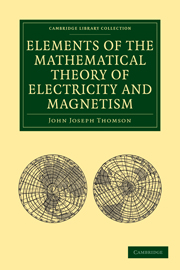Book contents
- Frontmatter
- PREFACE TO FIRST EDITION
- PREFACE TO THE SECOND EDITION
- PREFACE TO THE THIRD EDITION
- PREFACE TO THE FOURTH EDITION
- Contents
- CHAP. I General Principles of Electrostatics
- CHAP. II Lines of Force
- CHAP. III Capacity of Conductors. Condensers
- CHAP. IV Specific Inductive Capacity
- CHAP. V Electrical Images and Inversion
- CHAP. VI Magnetism
- CHAP. VII Terrestrial Magnetism
- CHAP. VIII Magnetic Induction
- CHAP. IX Electric Currents
- CHAP. X Magnetic Force due to Currents
- CHAP. XI Electromagnetic Induction
- CHAP. XII Electrical Units: Dimensions of Electrical Quantities
- CHAP. XIII Dielectric Currents and the Electromagnetic Theory of Light
- CHAP. XIV Thermoelectric Currents
- CHAP. XV The Properties of Moving Electric Charges
- INDEX
CHAP. I - General Principles of Electrostatics
Published online by Cambridge University Press: 07 September 2010
- Frontmatter
- PREFACE TO FIRST EDITION
- PREFACE TO THE SECOND EDITION
- PREFACE TO THE THIRD EDITION
- PREFACE TO THE FOURTH EDITION
- Contents
- CHAP. I General Principles of Electrostatics
- CHAP. II Lines of Force
- CHAP. III Capacity of Conductors. Condensers
- CHAP. IV Specific Inductive Capacity
- CHAP. V Electrical Images and Inversion
- CHAP. VI Magnetism
- CHAP. VII Terrestrial Magnetism
- CHAP. VIII Magnetic Induction
- CHAP. IX Electric Currents
- CHAP. X Magnetic Force due to Currents
- CHAP. XI Electromagnetic Induction
- CHAP. XII Electrical Units: Dimensions of Electrical Quantities
- CHAP. XIII Dielectric Currents and the Electromagnetic Theory of Light
- CHAP. XIV Thermoelectric Currents
- CHAP. XV The Properties of Moving Electric Charges
- INDEX
Summary
1. Example of Electric Phenomena. Electrification. Electric Field. A stick of sealing-wax after being rubbed with a well dried piece of flannel attracts light bodies such as small pieces of paper or pith balls covered with gold leaf. If such a ball be suspended by a silk thread, it will be attracted towards the sealing-wax, and, if the silk thread is long enough, the ball will move towards the wax until it strikes against it. When it has done this, however, it immediately flies away from the wax; and the pith ball is now repelled from the wax instead of being attracted towards it as it was before the two had been in contact. The piece of flannel used to rub the sealing-wax also exhibits similar attractions for the pith balls, and these attractions are also changed into repulsions after the balls have been in contact with the flannel.
The effects we have described are called ‘electric’ phenomena, a title which as we shall see includes an enormous number of effects of the most varied kinds. The example we have selected, where electrical effects are produced by rubbing two dissimilar bodies against each other, is the oldest electrical experiment known to science.
The sealing-wax and the flannel are said to be electrified, or to be in a state of electrification, or to be charged with electricity; and the region in which the attractions and repulsions are observed is called the electric field.
- Type
- Chapter
- Information
- Publisher: Cambridge University PressPrint publication year: 2009First published in: 1895



